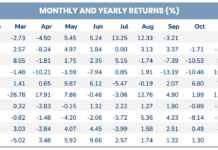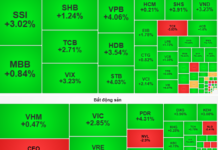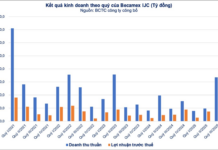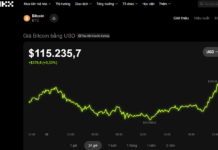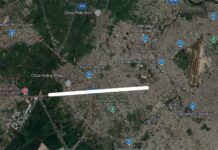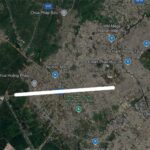A recent report highlights the development plans for the Dalat 18-hole golf course, which was established in 1922. Over the years, the popularity of golf has grown, and with it, the demand for ancillary services. As a result, the investors intend to construct a new golf club facility within the golf course premises. The Dalat golf course project is situated within a 62.4-hectare compound, encompassing the existing golf course.
The following structures will remain unchanged: the golf course, park, greenery, water bodies; the existing club house on Tran Nhan Tong Street; and the maintenance building on Tran Quoc Toan Street.
The new construction will include a new club house adjacent to Dinh Tien Hoang Street, comprising a reception block and Golf Service Blocks 1 and 2; along with several uncovered structures such as parking lots, internal roads, and open yards.
The project is bordered by the existing golf course on the east, south, and north sides, and by Golf Course Road 8 and Dinh Tien Hoang Street to the west. The total land area for the entire project is 624,038 square meters, divided into two sections: the golf course area and the themed park and service area. The expected timeline for completion is 1.5 years.

Source: Environmental Impact Report by Hoang Gia DL
|
The land composition within the golf course area includes 22,420 square meters of land for service tourism facilities (accounting for 3.59%); 407,501 square meters of land for golf course grass, greenery, and water bodies (65.3%); and 35,511 square meters of land for transportation, yards (6.17%).
The renovated golf club building will span an area of 5,625 square meters, with a maximum height of 19 meters; the maintenance building will cover 1,125 square meters, with a maximum height of one story; the newly constructed golf club building will measure 6,120 square meters, ranging from two to three stories; and the area for uncovered structures will be 9,550 square meters (1.53%).
The themed park and service area will occupy a total area of 118,438 square meters (18.98%), including the existing agricultural machinery building spanning 2,016 square meters, and the themed park and sports area covering 96,853 square meters (15.52%).
Hoang Gia DL’s report assesses the environmental impact of the project as follows:
– Surface water and land pollution by organic matter and microorganisms from domestic wastewater at the construction site: Moderate impact, short-term duration, regional scope (affecting one or more entities of the same nature significantly or when the impact affects an entire region), and potentially reversible.
– Air pollution by dust generated from excavation and backfilling activities (operation of construction machinery): Small impact, short-term, local scope (affecting a limited number of entities of the same nature within the project’s influence boundary or in close proximity), and potentially reversible.
– Dust pollution from road transportation activities: Small impact, short-term, local scope, and potentially reversible.
– Air pollution from welding and metal-cutting processes: Small impact, short-term, local scope, and potentially reversible.
– Community impact due to dust pollution: Small impact, short-term, local scope, and potentially reversible.
– Waste pollution: Moderate impact, short-term, point scope (affecting only a limited number of entities of the same nature within the project’s influence boundary), and potentially reversible.
– Community impact on livelihood due to soil erosion and silt deposition caused by rain: Moderate impact, short-term, regional scope, and potentially reversible.
– Loss of environmental aesthetics: Moderate impact, short-term, point scope, and potentially reversible.
– Land and surface water pollution by hazardous waste: Moderate impact on land and high impact on water, long-term, regional scope, and potentially reversible.
– Risk of water pollution from rainwater runoff carrying pollutants from the site’s surface: Small impact (organic matter) to high impact (oil), short-term (organic matter) to long-term (oil), regional scope, and potentially reversible.
– Impact from noise pollution: Small impact, short-term, regional scope, and potentially reversible.
– Impact from vibrations: Insignificant.
– Impact of vibrations on adjacent structures: Insignificant.
– Obstruction and safety hazards on existing roads due to construction at intersections: High impact, short-term, point scope, and potentially reversible.
– Increased risk of traffic accidents due to material spillage from transportation activities causing muddy and slippery roads: Moderate impact, short-term, point scope, and potentially reversible.
– Risk of disease transmission: Moderate impact, short-term, point scope, and potentially reversible.
– Potential for conflict: Moderate impact, short-term, point scope, and potentially reversible.
Previously, on January 11, 2024, the People’s Committee of Da Lat City issued a fine of VND 240 million to Hoang Gia DL for violations of construction permits and deviations from approved plans for the Da Lat Golf Course project.
In 2023, the company proposed developing a complex entertainment and resort area, along with two seven-story parking lots, on the Da Lat Golf Course site, spanning over 62 hectares. However, the People’s Committee of Lam Dong Province rejected this proposal as the suggested items were not included in the approved master plan.
Subsequently, an inspection by Da Lat City authorities revealed several violations. Hoang Gia DL was found to have constructed a golf club building at the 8th hole of the golf course (adjacent to Dinh Tien Hoang Street), which not only deviated from approved plans but also blocked the view of Langbiang Mountain, a symbol of Da Lat – Lam Vien Highland, from Xuan Huong Lake.
Additionally, within the Da Lat Golf Course compound, there were two large structures, one of which had a permitted area of 6,120 square meters. During construction, the investor illegally expanded this structure by more than 3,300 square meters. Moreover, an additional 4,400 square meters of construction, spanning four floors, was undertaken without the necessary permits. As a consequence, the authorities ordered the project to halt construction and complete the necessary paperwork.
Along with the fine, the authorities mandated that the company must stop construction and obtain the necessary permits. If permits are granted, the company is required to demolish all unauthorized structures and restore the site to its approved state within 90 days.
The Violations at Da Lat Golf Course: Was There Verbal “Consent”?
Hoang Gia DL disclosed its registered investment certificate for the Dalat Resort project (10th adjustment, dated June 15, 2022). The project encompasses a total land area of 714,820 square meters and a total investment of VND 2,000 billion. Of this, VND 848 billion is contributed capital, and nearly VND 1,152 billion is borrowed capital.
One of the key components of the Dalat Resort project is the construction of a new golf club building, comprising a reception area and service blocks, with a total area of 6,120 square meters – matching the area mentioned earlier for the new golf club building. Additionally, there are plans for parking lots covering a total area of 9,550 square meters. According to the projected timeline, construction is expected to commence in Q2 2022 and be completed by Q2 2025, after which the facility will be operational.
Dau Truong Thien Ly, a runner-up in a beauty pageant, holds a 78% stake in Hoang Gia DL.
Hoang Gia DL, formerly known as DRI, was established in 1991 with a total investment of USD 40 million and a planned operational period of 20 years. The capital structure comprised 50% domestic investment and 50% foreign investment.
The Vietnamese side contributed the right to use 947,563 square meters of land for 20 years, valued at over USD 13.1 million (including land rent for the entire 20-year period from 1991 to 2011); existing assets of the golf course, Dalat Palace Hotel, DuParc Hotel, Dinh 1, and 16 villas on Tran Hung Dao Street, valued at nearly USD 6.9 million.
The foreign investment included USD 16.5 million for the creation and upgrade of physical assets; USD 3 million for transportation means; and USD 500,000 in foreign capital for working capital.
 Dau Truong Thien Ly
|
In 2005, the two parties signed a contract for the transfer of investment value in the DRI joint venture, transforming the investment format to 100% foreign-owned. The contract stipulated that the investor would transfer assets to the People’s Committee, including Dinh 1, 14 villas on Tran Hung Dao Street, and a transfer value of USD 14.1 million.
In 2015, Danao Limited (based in the British Virgin Islands) appeared in Hoang Gia DL’s business registration papers as the owner of the enterprise, holding 100% of the capital (VND 437.8 billion).
By April 2016, the company’s charter capital had reached over VND 848 billion, which is also the amount of cash the company had to contribute to realize the Dalat Resort project.
An updated list of shareholders from mid-2022 revealed that Dau Truong Thien Ly contributed VND 661.5 billion (78% of charter capital), Nguyen Thi Kim Phuong contributed VND 178.1 billion (21%), and Tran Ngoc Nhat contributed nearly VND 8.5 billion (1%).
Nguyen Hoang Vu is currently the General Director and legal representative of Hoang Gia DL.
Deputy Prime Minister: Comprehensive Environmental Impact Assessment of the Can Gio ‘Mega Port’
As the Can Gio port project is associated with Vietnam’s first-ever World Biosphere Reserve, it holds immense value and significance for Ho Chi Minh City and the region. Due to its potential environmental implications, Deputy Prime Minister Tran Hong Ha has emphasized the need for a thorough and comprehensive assessment of its environmental impact.














